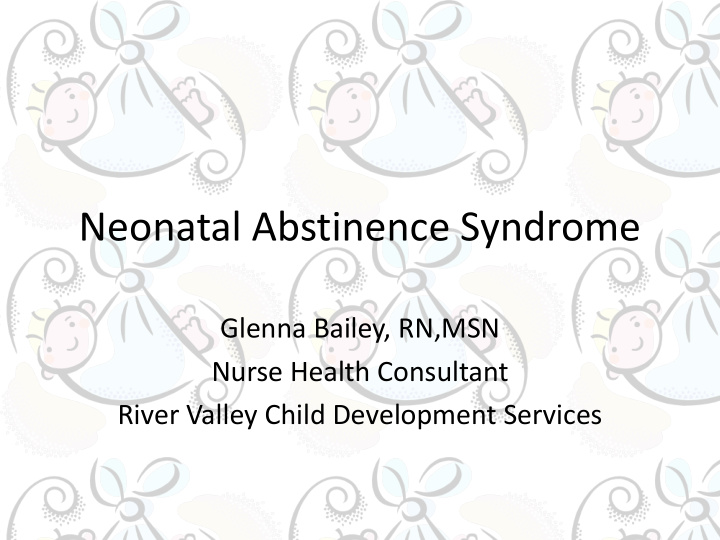



Neonatal Abstinence Syndrome Glenna Bailey, RN,MSN Nurse Health Consultant River Valley Child Development Services
How Bad is the Problem? • Highest overdose deaths in the nation at 28.9 per 100,000. • The number of drug overdose deaths - a majority of which are from prescription drugs - in West Virginia increased by 605 percent since 1999 when the rate was 4.1 per 100,000.
2009 Study by MU Medical Center • Bluefield Regional Medical Center (BRMC) • Raleigh General Hospital (RGH) • Thomas Memorial Hospital (TMH) • Charleston Area Medical Center (CAMC) • Cabell Huntington Hospital (CHH) • Ruby Memorial Hospital (RMH) • Wheeling Hospital (WH) • City Hospital Martinsburg (CH)
759 Total Umbilical Cord Samples Hospital Number % of Total • BRMC 50 6.6 • RGH 83 10.9 • TMH 59 7.8 • CAMC 133 17.5 • CHH 245 32.2 • RMH 52 6.9 • WH 65 8.6 • CH 72 9.5
Results Drug Class Number % of Positives (146) % of population (759) • Amphetamines 1 <1 <1 • Cocaine 0 0 0 • Opiates 41 28 5.4 • Cannabinoids 58 40 7.6 • Benzodiazepines 17 12 2.2 • Methadone 14 10 1.8 • Alcohol 39 27 5.1
Poly Pharmacy was very common
Benzodiazepines • CNS depressants • Ativan (lorazepam), Dalmane (flurazepam), Diastat or Valium (diazepam), Doral (quazepam), • Halcion (triazolam), Klonopin (clonazepam), Librium (chlordiazepoxide), Paxipam (halazepam), • ProSom (estazolam), Restoril (temazepam), Serax (oxazepam), Tranxene-SD (clorazepate), , • Xanax (alprazolam)
Methadone • Methadone is an opioid medication. An opioid is sometimes called a narcotic. Methadone reduces withdrawal symptoms in people addicted to heroin or other narcotic drugs without causing the "high" associated with the drug addiction.
Withdrawal Onsets Drug Approximate time to onset of withdrawal symptoms • Barbiturates 4-7 days but can range from 1-14 days • Cocaine Usually no withdrawal signs but sometimes neurobehavioral abnormalities (decreased arousal and physiologic stress) occur at 48-60 hours • Alcohol 3-12 hours • Heroin Within 24 hours • Marijuana Usually no clinical withdrawal signs • Methadone 3 days but up to 5-7 days; rate of severity of withdraw cannot be correlated to dose of maternal methadone • Methamphetamines Usually no withdrawal signs but sometimes neurobehavioral abnormalities (decreased arousal, increased physiologic stress, and poor quality of movement) occur at 48-60 hours • Opioids 24-36 hours but can be up to 5-7 days
Neonatal Abstinence Syndrome • NAS refers to a cluster of symptoms in a newborn due to substance abuse of opioids and/or sedatives of the mother during pregnancy. • Opioids: Pain medications such as oxycontin, morphine, codeine, hydrocodone. • Sedative : Drug taken for calming effect such as xanax. • Heroin: A opioid derivative of morphine but illegal in any form.
• Clinical presentation of opioid withdrawal: – Clinical presentation varies with the opioid, history of maternal substance use, maternal metabolism, transplacental drug transfer, and infant metabolism and excretion. – The central nervous system and gastrointestinal tract are most commonly affected. – Onset ranges from within ages 24 to 72 hours. – Subacute symptoms can last up to 6 months. – Seizures occur in 2% to 11% of infants, and abnormal electroencephalogram results occur in more than 30% of infants.
Withdrawal • NAS generally is a result of the infant withdrawing from the drug. • Onset usually occurs during the first 2-7 days and peak between 10-21 days. • May last up to 6 months. • Withdrawal in full term infants many begin earlier in first 1-2 days.
Signs and Symptoms • Excessive or high-pitched crying. • Sleeplessness • Tremors, jitteriness • Sweating • Nasal stuffiness • Excessive sucking • Poor feeding • Vomiting and diarrhea • Seizures
Video
Management of Withdrawal • Baby may be weaned from medication with decreasing doses of morphine or methadone. • Sometimes phenobarbital is added and/or used as outpatient medication. • Phenobarbital is central nervous system depressant. Helps relieve symptoms including seizures.
Supportive Management • Quiet and calm environment • Slow, steady handling with quiet voices. • Dim lighting. • Gentle massage. • Organize care to minimize handling.
Supportive Management • Swaddling • Can result in fewer tremors, stable respirations, and better sucking. • Not too tight or no overdressing. • Don’t want blanket over the face or don’t want to overheat.
Video
Supportive Management • Respond to distress cues. • Feed on demand and feed in a quiet environment. • May need small feeds with frequent rests. • Use a pacifier • Use mittens to prevent scratching and over sucking of fists. No lotions or creams on hands as baby might suck it.
Supportive Management • Frequent bowel movements may lead to severe skin irritation. • Check diaper frequently. • Use diaper ointment for prevention and treatment.
Supportive Management Be on the lookout for signs of dehydration • Thirst • Less elasticity in the skin • Eyes and fontanel (or soft spot on head) appear sunken • Decrease or absence of tears • Dry mouth • Decrease number of wet diapers
Individual Health Care Plans • Many of these techniques are contrary to what you have been taught. • Individualized health care plans are a must. Orders and instructions from the physician must be in writing to support medication administration, swaddling, and perhaps alternate sleeping positions.
Activity • What are some of the barriers to caring for these infants in a child care setting? • Suggestions to help meet the need in the child care setting.
Recommend
More recommend